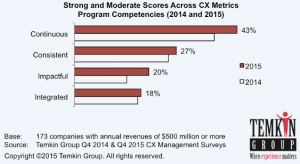I hate to break it to you, but when it comes to customer metrics, there is no silver bullet.
On one hand, we have the enterprise-level customer experience measures that are largely vanity metrics – NPS (Net Promoter Score), Customer Effort Score (CES), or Customer Satisfaction (CSat) – and offer some, but limited, actionable insights.
On the other hand, we have a plethora of granular operational metrics, measured in isolation, and rarely aligned with either enterprise-level customer metrics or business outcomes.
With the lack of clear linkage between CX Metrics and business outcomes, these CX Metrics then become mere guidelines and are rarely used effectively to shape business strategy decisions. This is consistent with the findings from the Temkin Group.
Temkin Group’s annual research reveals that majority of companies are still struggling to get it right.
Temkin Group’s evaluation methodology of CX Metrics Programs is based on four dimensions:
- Consistent (does the company use common CX metrics across the organization?)
- Impactful (do the CX metrics inform important decisions?)
- Integrated (are trade-offs made between CX and financial metrics?)
- Continuous (do leaders regularly examine the CX metrics?)
Findings indicate that companies are collecting customer experience metrics data on a regular basis, only 20% (approximately) use that information to make key strategic decisions.
The Holy Grail
The holy grail for business strategists is the ability to establish a link between customer insights and profitable business results. In other words, for customer experience metrics to take center stage in business decision making, it is imperative to create a credible ‘line of sight’ from customer feedback to business outcomes.
While possible, this is not easy.
Key to success are C-Suite supported, resourced, and funded program that is supported by a robust data infrastructure that integrates customer interaction data, with customer feedback data.
Successful implementation will require a deliberate, disciplined, iterative approach. There are two key concepts that will help in our quest – A Metrics Map and Statistical Linkage methodology.
A Metrics Map
Forrester classifies CX Metrics into – Descriptive, Perceptive, and Outcome metrics.
Descriptive metrics measure and track what happened, or in other words, are observable characteristics of customer interactions e.g. response time for social media or web chat, call handle time, first call resolution, average pages per visit online, etc.
Perceptive metrics evaluate how the customer felt during the customer interaction, or in other words, are a measure of customers’ subjective perception of customer interactions, e.g. customer satisfaction with the interaction, perception of effort, overall satisfaction, etc.
Outcome metrics track customer action based on the history of their interactions with the company, or in other words, what customers actually do after their interactions.
A metrics map is a relationship map between Descriptive, Perception, and Outcome metrics. The metrics map forms the foundation of the CX Metrics program. “Linkage Analysis” helps define the relationship.
Linkage Analysis
Bob Hayes introduced the idea of using “Linkage Analysis” for establishing the link between different Customer Experience metrics in his book Total Customer Experience management. Linkage Analysis stands for linking business variables in cause and effect relationships using statistical methods such as Correlation Analysis and Analysis of Variance to determine linear and non-linear relationships.
To be continued …
—————————————————————-
Inspiration:
- State of Customer Experience Metrics: Improving!, Bruce Temkin LinkedIn Blog (Link)
- Total Customer Experience, Bob Hayes, 2013
- Forrester Report: Seven Steps To Successful Customer Experience Measurement Programs by Maxie Schmidt-Subramanian, June 27, 2013






You’ve referred to work in this area done by Temkin Group. About eighteen months ago, Bruce Temkin had a blog on the subject (Customer Effort, Net Promoter…..identified above). You’ll see my comment on Bruce’s blog, and links to a couple of my own posts where customer advocacy behavior measurement is discussed. Over the years, I’ve generated many white papers, articles, and blog posts about advocacy as an actionable and relevant metric.
Customer advocacy meets (and has met for over a decade) the four measurement criteria of consistency, impactfulness, integration and continuity identified by Temkin Group. I’d invite you to learn more about it.
Just curious – my wife and I have a good friend, Anand (Andy) Bhattacharya, also from Varanasi, who lives in the Philadelphia area, Are you related?.